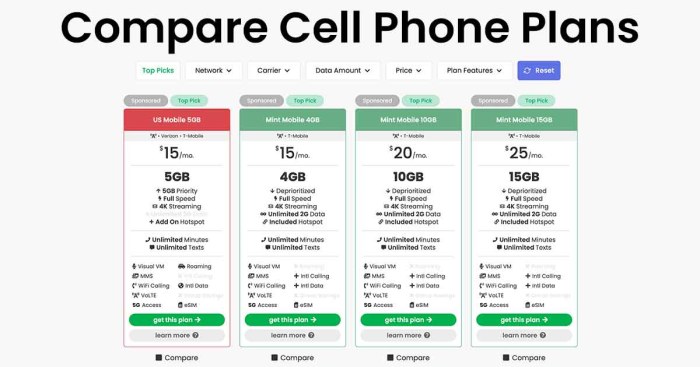Smartphone Plan Compare: Finding the Best Fit takes center stage, navigating the complex world of mobile phone plans. This guide offers a comprehensive analysis of different plan types, carrier comparisons, and essential considerations to help you make an informed decision.
From understanding the basics of prepaid and postpaid plans to exploring the nuances of data usage and contract vs. no-contract options, this guide equips you with the knowledge needed to choose a plan that aligns with your individual needs and budget. We’ll delve into the intricacies of carrier pricing, features, and hidden fees, providing a clear roadmap for finding the perfect smartphone plan for your lifestyle.
Switching Carriers
Switching mobile carriers can be a good way to save money or get a better plan. It’s a relatively simple process, but there are some things you should know before you make the switch.
Potential Costs and Penalties
Switching carriers can sometimes involve costs and penalties. It’s important to understand these potential costs before you make the switch.
- Early termination fees: If you’re still under contract with your current carrier, you may have to pay an early termination fee (ETF) to break your contract. This fee can be significant, so it’s important to check your contract before you switch.
- Remaining balance on your phone: If you’re financing your phone through your current carrier, you may have to pay off the remaining balance on your phone before you can switch.
- Activation fees: Most carriers charge an activation fee when you switch to their service. This fee can vary depending on the carrier.
Switching Process
The process of switching carriers is usually straightforward. Here’s a general overview of the steps involved:
- Choose a new carrier: The first step is to choose a new carrier. Consider factors like pricing, coverage, and data plans.
- Check your contract: If you’re under contract with your current carrier, make sure you understand the terms of your contract and any potential early termination fees.
- Order a new SIM card: Your new carrier will likely send you a new SIM card. You’ll need to insert this SIM card into your phone to activate your new service.
- Transfer your number: You can usually transfer your existing phone number to your new carrier. This process typically takes a few days.
- Activate your new service: Once you’ve inserted your new SIM card, you’ll need to activate your new service. You can usually do this by calling your new carrier or by following the instructions on their website.
Tips for a Smooth Carrier Switch, Smartphone plan compare
Here are some tips for making the switch as smooth as possible:
- Contact your current carrier: Before you switch, contact your current carrier to let them know you’re leaving. This will help you avoid any unexpected charges.
- Check your phone’s compatibility: Make sure your phone is compatible with your new carrier’s network. If it’s not, you may need to buy a new phone.
- Back up your data: Before you switch carriers, back up your data to the cloud or to your computer. This will ensure that you don’t lose any important information.
- Keep your old phone: It’s a good idea to keep your old phone for a few days after you switch carriers. This will give you time to make sure that everything is working properly with your new service.
Ultimate Conclusion: Smartphone Plan Compare
In the end, finding the ideal smartphone plan is a personal journey. By carefully evaluating your usage patterns, budget, and priorities, you can confidently navigate the options and select a plan that delivers exceptional value and meets your specific requirements. Remember to stay informed, compare offers, and leverage the resources available to ensure you’re making the most informed decision possible.
Comparing smartphone plans can be a bit overwhelming, especially when you’re trying to find the best value for your money. One important factor to consider is the type of phone you want, and if you’re looking for a great smartphone within a budget of 20,000, you can check out some great options here.
Once you’ve narrowed down your phone choices, you can then compare plans based on data, calling minutes, and other features to find the best deal for your needs.
 Informatif Berita Informatif Terbaru
Informatif Berita Informatif Terbaru
